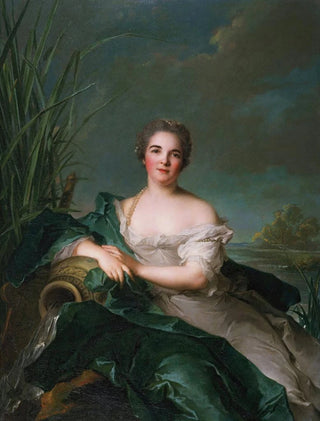Art print | Madame de Flesselles - Jean-Marc Nattier


View from behind

Frame (optional)
Madame de Flesselles - Jean-Marc Nattier – Captivating Introduction
In the world of art, certain works transcend time and capture the very essence of their era. "Madame de Flesselles" by Jean-Marc Nattier is one of those iconic creations that, through its elegance and depth, continues to fascinate art enthusiasts. Created in the 18th century, this painting embodies not only the beauty of a woman but also the spirit of a period marked by refinement and sophistication. Through this portrait, Nattier manages to immortalize a female figure who, although rooted in a specific historical context, evokes universal emotions. The art print of this work allows you to appreciate the magic of painting while discovering the subtleties of French aristocratic life.
Style and uniqueness of the work
Nattier's style is distinguished by its delicate approach and mastery of colors. In "Madame de Flesselles," the artist uses a soft and harmonious palette that creates an atmosphere of serenity. The play of light on the protagonist's face reveals finesse in the rendering of features, while the drape of her dress evokes lightness and movement. This portrait is not limited to a simple physical representation; it also reveals the personality of its model. The gentle, contemplative expression of Madame de Flesselles suggests introspection, a depth of soul that invites the viewer to admire her beyond her external beauty. The meticulous details, from sparkling jewelry to the textures of fabrics, testify to exceptional craftsmanship and attention to every element of the composition.
The artist and his influence
Jean-Marc Nattier, a central figure in 18th-century French portraiture, established himself as one of the most prominent painters of his time. A student of the academician Antoine Watteau, Nattier developed a style that combines rococo influences with a more intimate sensibility. His work is marked by a constant pursuit of harmony and beauty, characteristic of an era where art served social representation and aesthetics. Nattier had the honor of painting numerous court figures, and his talent led him to

Matte finish

View from behind

Frame (optional)
Madame de Flesselles - Jean-Marc Nattier – Captivating Introduction
In the world of art, certain works transcend time and capture the very essence of their era. "Madame de Flesselles" by Jean-Marc Nattier is one of those iconic creations that, through its elegance and depth, continues to fascinate art enthusiasts. Created in the 18th century, this painting embodies not only the beauty of a woman but also the spirit of a period marked by refinement and sophistication. Through this portrait, Nattier manages to immortalize a female figure who, although rooted in a specific historical context, evokes universal emotions. The art print of this work allows you to appreciate the magic of painting while discovering the subtleties of French aristocratic life.
Style and uniqueness of the work
Nattier's style is distinguished by its delicate approach and mastery of colors. In "Madame de Flesselles," the artist uses a soft and harmonious palette that creates an atmosphere of serenity. The play of light on the protagonist's face reveals finesse in the rendering of features, while the drape of her dress evokes lightness and movement. This portrait is not limited to a simple physical representation; it also reveals the personality of its model. The gentle, contemplative expression of Madame de Flesselles suggests introspection, a depth of soul that invites the viewer to admire her beyond her external beauty. The meticulous details, from sparkling jewelry to the textures of fabrics, testify to exceptional craftsmanship and attention to every element of the composition.
The artist and his influence
Jean-Marc Nattier, a central figure in 18th-century French portraiture, established himself as one of the most prominent painters of his time. A student of the academician Antoine Watteau, Nattier developed a style that combines rococo influences with a more intimate sensibility. His work is marked by a constant pursuit of harmony and beauty, characteristic of an era where art served social representation and aesthetics. Nattier had the honor of painting numerous court figures, and his talent led him to






